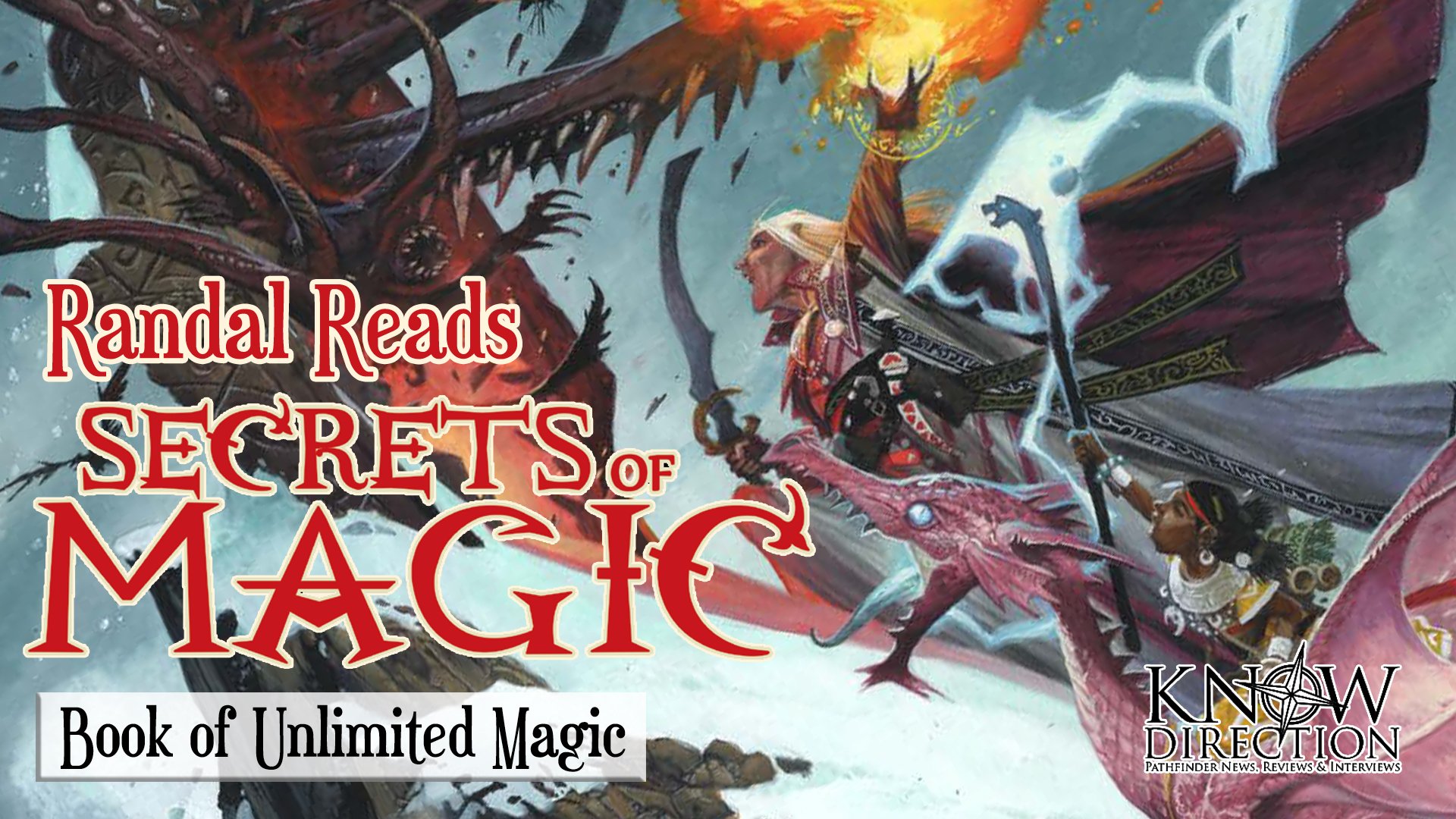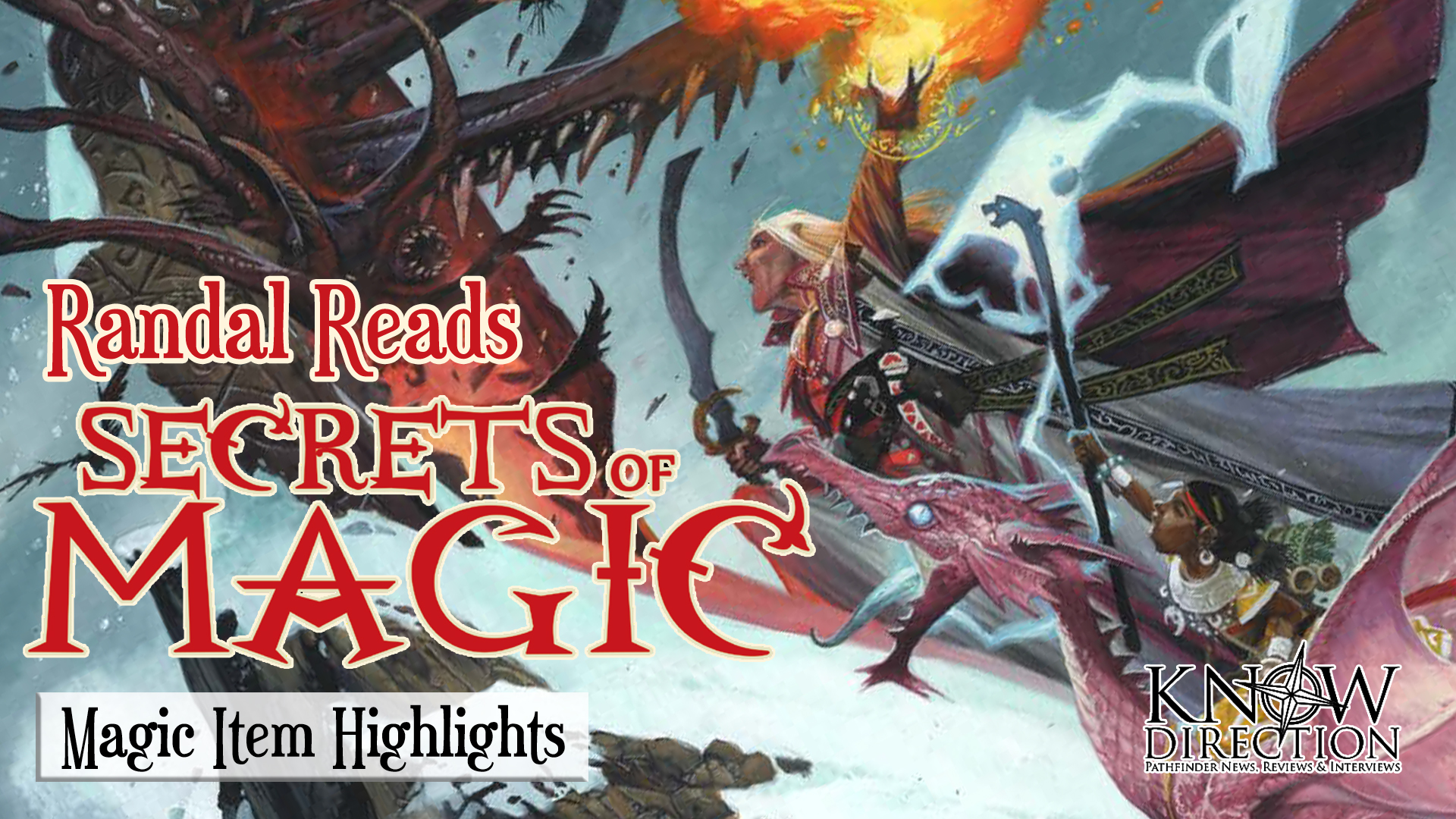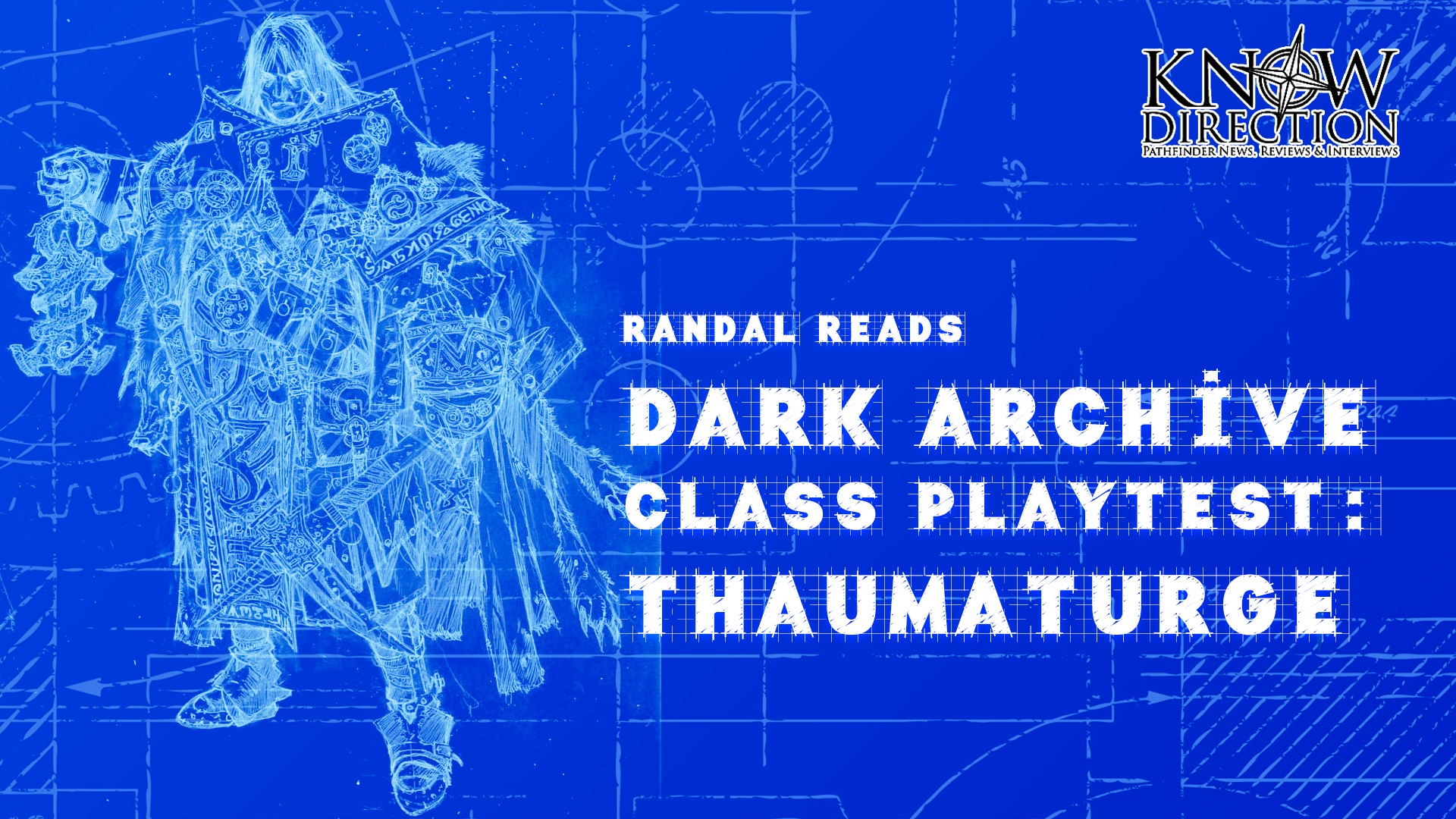Welcome back to the conclusion of the Secrets of Magic special review blog! If you missed the beginning, you can find it here! Yesterday, I shared my favorite new magic items with you. Today, we finally reach all the new variant magic systems in:
Book of Unlimited Magic
This is it. We’ve finally made it. The last chapter. The most (by my unscientific lack of polling) controversial part of any game system … variant magic systems. There is a lot to cover here, so I just want to mention that this first page lists a brief summary of each variant in a single (but long) sentence with a sidebar that includes a reminder of accessing things with rarity as well as a refresher on class archetypes. Strap in, buckle up, grab a snack. HERE. WE. GO.
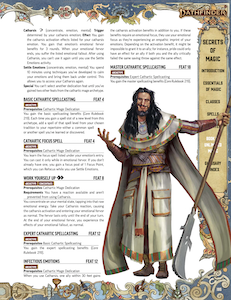 Cathartic Magic
Cathartic Magic
This is not something I recall seeing in Pathfinder 1e, nor really hearing about much in any other system (admittedly I haven’t played as many systems as I should; or even own). The basic run down is that cathartic mages get/use their magic via a heightened emotional state, not unlike a barbarian’s rage. This 4 page spread includes the archetype’s explanation, dedication, and other feats (2 pages) as well as the Emotional states you choose from when you take the archetype (2 pages). Each Emotional State block is made up of: Catharsis Trigger, Catharsis Activation, Emotional Fervor (with Spell), Emotional Fallout, and Focus Spell. The available emotions are Anger, Awe, Dedication, Fear, Hatred, Joy, Love, Misery, Pride, Remorse. I … don’t know what I think about this one, actually. I love the roleplay potential, but (as noted in the text) worry about groups that either gloss over or get bogged down by the roleplay that is needed for this concept to really work right. I will have to put together a build to see what I think about it.
Cathartic Mage Dedication (2nd) – Taking the archetype gives you the Catharsis Reaction, which enables you to use your Catharsis Activation when you meet your Catharsis Trigger, you then gain the Emotional Fervor for 3 rounds (during which you can use a slot to cast your fervor spell) before suffering the Emotional Fallout. You must Settle Emotions (essentially Refocus) to allow you to use Catharsis again. Note: This doesn’t require you to be a caster, and thus has Basic Cathartic Spellcasting (4th), Expert Cathartic Spellcasting (12th), and Master Cathartic Spellcasting (18th) as available feats.
Cathartic Focus Spell (4th) – Gain the focus spell associated with your Emotional State.
Work Yourself Up (8th) – This 2 action activity allows you to trigger your own Catharsis.
Here’s an example: Fear; Your trigger is gaining the frightened condition. Your activation is that you increase the value by 1. Your 3 round fervor is that you don’t suffer the status penalty to DCs or spell attacks, instead gaining a bonus equal that penalty, and you can use a spell slot to cast fear. Your fallout is that you are fleeing for 2 rounds. The associated focus spell is waking nightmare.
 Elementalism
Elementalism
This section takes a look at magic based on the 4 elements of air, earth, fire, and water. This world view takes different forms to different groups or individuals. There is a nice sidebar on the philosophical attributes of the elements.
Druidic Orders
This adds 3 new Orders (Flame, Stone, and Wave) to augment the Storm that we already know. Each new Order receives feats at 1st, 4th, 6th (this one includes Storm), and another later (Flame at 8th, Stone at 10th, Wave at 12th). The section also includes 8 new focus spells, two for each of the elements (Orders), one they get with their Order at 1st, and one they can take at 6th with the Advanced Elemental Spell feat. These 4 pages are compatible with, but do not require, the Elementalist archetype and spell list.
Monk Stances
This page offers up two new elemental (fire, water) stances (3 feats each) to augment the two that already exist (Mountain Stance and Wild Winds Initiate).
- Reflective Ripple Stance (1st) – 1d6 B; agile, disarm, finesse, nonlethal, trip, unarmed, water; +1 to Disarm, Swim, Trip and +2 to avoid Disarmed and Tripped
- Rippling Spin (8th) – React to a hit by Stepping and disarming/tripping attacker
- Wave Spiral (12th) – 2 actions to trip all creatures within 10 ft emanation
- Stoked Flame Stance (1st) – 1d8 S; forceful, nonlethal, sweep, unarmed; +5 ft Speed
- Inner Fire (6th) – col/fire resistance and attackers take fire damage
- Blazing Streak (10th) – 3 actions to Stride twice and attack 4 creatures anywhere i your path
I really like the flavor in these feats and I think they represent their elements well. I can easily see playing a monk that focuses on the elements and learns these.
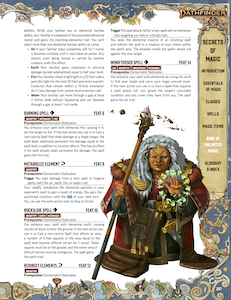 Elemental Spell List
Elemental Spell List
This is the spell list as seen by an elementalist that eschews the standard 4 traditions. I am not going to relist what you can find in many other places, but I wanted to touch on it for those of you that don’t have access yet. It includes spells from “all hardcover rulebooks up to” (and including) Secrets of Magic. Glancing at the list, without digging into all the spells on it, I feel like they did a great job of providing all the utility spells you will need that aren’t explicitly elemental in nature, like Read Aura, Mage Armor, Dispel Magic, etc. There is a sidebar, discussing Elementalism on Golarion, that mentions Elemental Lord Cults, Elemental Saturations, and Monks.
Elementalist (Class Archetype)
This is one of those archetypes you are likely going to want to read a couple times just to make sure you didn’t miss anything. Especially because you can take it at first level (altering your class) and you must take the 2nd level dedication feat. You must have the arcane or primal tradition to even take this archetype, and it outlines other special changes that druids, sorcerers, and wizards will need to make.
Elementalist Dedication (2nd) – You attune to an element each day, gaining resistance to it.
Other feats available to elementalists allow you to use an element as metamagic to augment a spell, alter your familiar, and even redirect elemental spells that miss you. I realy look forward to figuring out my first elementalist build, and yeah, I will have a bird familiar that always has the fire ability so that I have a “phoenix” familiar.
Flexible Preparation
Moving on from Elementalism, we get to my favorite caster from 1st edition … the Arcanist. Well, sort of. Mostly. This 2 page spread starts with some canon/flavor on the concept of flexible spellcasters along with a new table for spells per day. Basically, you gain spells at the same rate (start with 3 cantrips but eventually reach 5) but you never have more than 2 spells per day at any slot (and you don’t get 10th level slots automatically). Your collection of spells you prepare daily is the same as your total spell slots per day (starting at 2 and capping at 18). Again, if you choose these archetype (which you do at 1st-level), you must take the Flexible Spellcaster Dedication at 2nd level. There are a couple caveats (like you must always have a 1st level spell in your collection to avoid unusable slots) as well as rules on adjudicating some other class feats/features (like Counterspell) along with a list of disallowed feats (like Reprepare Spell).
All in all, I love this, am super glad to see it, and am really excited that it was done in a way that lets you apply it any spellcaster that normally prepares spells (instead of being separate class of alternate wizards).
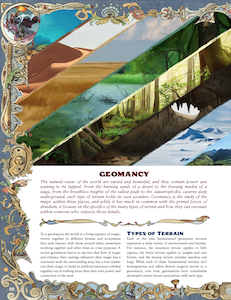 Geomancy
Geomancy
These 4 pages discuss the concept of geomancy (magic based on the biomes and ecosystems of the world). The types of terrain outlined for the Geomancer to use are: Aquatic, Arctic, Desert, Forest, Mountain, Plains, Sky, Swamp, and Underground. Each of these gets a paragraph write up that provides a nice reminder of what you will find and a note on how a geomancer taps into its power. The archetype is a standard 2 page spread.
Geomancer Dedication (2nd) – Requires training in Nature and spell slots and at least one spell with air, cold, earth, fire, plant, or water. When you cast a spell with a trait that matches your current terrain, you gain a terrain attunement effect. Example: Aquatic, you gain a Swim speed if you are in the water.
Other feats available to geomancers include the ability to share attunement with allies, ignore difficult terrain, commune with the land, use the terrain to block attacks, and even shift the terrain itself.
Ley Lines
I have always enjoyed the idea of ley lines, but have never really dug into them. I really enjoyed reading the Golarion canon for them. There are sections for Ley Lines in your Game as well as Locating Ley Lines and Ley Line Nodes. There is a new action, Tap Ley Line, that you can use to try to gain the benefit of a ley line, along with some sample ley line stat blocks (5; each with level, traits, benefit, and backlash), as well as two rituals: Empower Ley Line (7th) and Establish Nexus (5th). Some example benefits of ley lines include modifying a spell with metamagic, adding persistent damage, or spell heightening. While I run printed material mostly these days, I look forward to either seeing them in a module … although, I might just add a side quest that involves one.
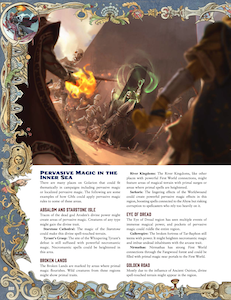 Pervasive Magic
Pervasive Magic
This variant is for game groups that really like magic to be everywhere. There are examples for how to explain how or why there is so much magic, if you need that sort of thing. With this in play, every creature has a tradition trait, and a cantrip from that tradition. There are 3 new backgrounds, 4 feats available (although, the feats are really just generic multiclass “cantrip/basic/expert/master spellcasting” feats), and tables for each tradition that include some suggested spells that creatures of a certain level can cast once per day. Additionally there are rules for magical terrain such as Energy Surge, Heightened, Metamagic, Occult, Primal, and Spell-Touched terrain. The last two pages list areas around the Inner Sea that could be considered to have Pervasive Magic, such as Starstone Cathedral (divine spell-touched), Gallowspire (heighten necromancy), Eye of Abendego (heighten and enhance air/wind), Jalmeray (heighten elemental), Lands of the Linnorm Kinds (primal magic), and many more.
Shadow Magic
While this isn’t an avenue that I have dabbled much in, I can appreciate what it offers. A darker (get it), edgier, mysterious side to magic, or a character, or an entire campaign.
Shadowcaster Origins
After a quick description of shadowcasters, companions, and familiars, this section discusses the origins of shadowcasters. It gives suggestions about where or how characters from different regions might get into the arts, trading their access to light for the powers of shadow. Cheliax, the Crown of the World, Geb, the Mwangi Expanse, Nidal, Sarkoris, the Shadow Plane, and Ustalev are all mentioned here in the first 2 pages.
 Shadowcaster (Archetype)
Shadowcaster (Archetype)
The Shadowcaster archtype is given in a standard 2 page spread, and in addiiton to the new feats presented, the archetype provides access to additional feats from the Core Rulebook (2; familiar related) and Advanced Player’s Guide (4; shadow related).
Shadowcaster Dedication (2nd) – Lose access to light spells, gain cloak of shadow domain spell.
Shadow Spells (4th) – Add a bunch of shadow spells (new and old) to your spell list
Disciple of Shade (6th) – Gain inscrutable mask domain spell. This 2 action spell grants you a bonus to Deception (Lie/Feint), Intimidate (Demoralize), and Stealth (Hide) when in dim light or darkness.
Shadow Spell (8th) – This metamagic lets you help (+2 Stealth) or hinder (-2 Perception) the target of your next spell via your shadow
Shadow Reservoir (10th) – This is the kind of feat that gets me to try out new character builds. Your shadow gains a reservoir of spells that it can allow you to cast in place of your normal spells, separate from your spells known / repertoire.
Secrets of Shadow (12th) – Enhance your shadow’s repertoire and gain resistance to negative (or positive)
Unending Emptiness (14th) – You gain the darklight domain spell. This 3 action spell creates a 20 ft burst that suppresses magical light and doesn’t let natural light pass through (can’t see in, can’t see out). Even with darkvision (but not greater), the boundary makes them concealed. The field causes 2d6 B and 2d6 negative damage each round, for 1 minute. This is the kind of spell that can make or break and encounter, and possibly an adventure.
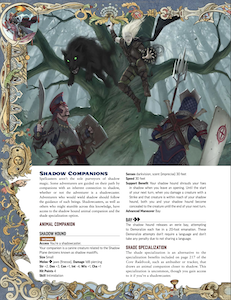 Shadow Companions
Shadow Companions
What, more shadow stuff!? This section outlines the Shadow Hound animal companion, available to shadowcasters. Kind of to be expected, they have Intimidation, darkvision, scent, and their support benefit is to conceal you both. Their advanced maneuver, Bay, is a 2 action Demoralize in a 20 ft emanation. Also included is an alternate specialization, Shade, that alters other companions to gain darkvision, resistances, a longer Step in darkness, and expert in unarmored defense.
Shadow Familiars
But wait, there’s more!? Yes, you can turn your own shadow into your familiar … now I wanna play Peter Pan as an occult pirate sea witch … This specific familiar requires 7 abilities and can Become Shadow (become flat, slip through cracks), Slink in Shadows (Hide/Sneak in shadows), and Steal Shadow (enfeeble). Additionally, there are two new familiar abilities offered up: Darkeater (recover HP in shadows) and Shadow Step (teleport in dim/darkness).
When I saw the Shadow Magic header, I wholly expected something more like the Elementalism section (spell list, monk feats, and archetype). I was very surprised, and really enjoyed what we got instead. The animal companion and familiar options really added and made it feel different.
Soul Seeds
This is not something I am aware of or have heard of (if it is something that existed prior to this book). Touted as a special form of relic that is bound to the soul of a creature, these Gifts come in Minor, Major, and Grand form and are split between Dragon Gifts and Soul Gifts. Minor gifts offer things like elemental resistance or 1/day breath weapon, while major gifts offer 1/day flight or blink, and the grand gifts can dragon form (1/hour) or divine inspiration (1/day). In the “Using Soul Seeds” section it offers some suggestions for how these can come into your game, such as being born with it or awakening it through powerful emotions. I suddenly have the urge to try a hybrid monster hunter / Highlander campaign where you actively hunt creatures for their Gift.
 Soulforged Armaments
Soulforged Armaments
This, to me, seems like a mishmash of previous concepts (from PF1e and other games) into something new and fitting the theme of this book. You gain an armament that is linked to you, forged from “soul stuff”, and can be manifested or dismissed as needed. There is a ton of flavor here, and it all feels new, fun, and thorough. Because they are tied to your soul, and a motivation/cause (Soul Path), anathematic acts on your part can cause you to be cursed. There is an exploration activity and ritual for dealing with this curse (Soulforged Corruption). Rules for upgrading, reshaping, restoring, and a sidebar for Soulforged Champions. The archetype is only made up of the 4 feats Soulforger Dedication (2nd), Soul Flare (4th), Rapid Manifestation (6th), and Soul Arsenal (6th) but includes an entire page of Essence Powers to choose from when you take the dedication. I think my favorite thing here, is that a Soulforger Magus is the 2e Black Blade … complete with art for it.
Thassilonian Rune Magic
Surprising nobody, we get a run down on the seven schools of Thassilonian rune magic: envy (abjuration), gluttony (necromancy), greed (transmutation), lust (enchantment), pride (illusion), sloth (conjuration), and wrath (evocation). An almost full page spread brushes you up on your history of the runelords, followed by half a page listing each school, it’s prohibited schools, and its rune spells (as used by the Runelord class archetype on the following pages).
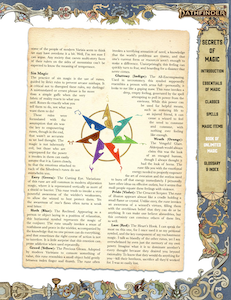 Runelord (Archetype)
Runelord (Archetype)
You get quite a bit taking this archetype … a rune spell at 1st (and another at 8th) and extra focus to use them (in addition to the focus you already have for being a specialist wizard), training in polearms (and eventually expert and weapon expertise) … for the price of not being able to cast spells from your 2 prohibited schools. The Runelord Dedication (2nd) adds a cantrip, and ensures you learn more spells at each level. Embed Aeon Stone (2nd) lets you embed one in your flesh while Aeon Resonance (4th) acts as a wayfinder. You can get Polearm Tricks (6th), a Sin Reservoir (8th), and even a Fused Polearm (10th) to always have a staff at hand! At 12th, you can School Counterspell (use any spell from that school) which leads you to School Spell Redirection at 18th (send a countered spell back at caster). There is even a new focus spell for Sloth that lets you summon an item instead of walking over to pick it up.
The final 2 page spread is wonderful “A Little Chat about Runes” by Queen Sorshen. This discusses the visual manifestations of spells that we have seen in the art since! It covers the basics of Rune Magic: Runes, Sihedron, Sin Magic, and the colors associated with the sins/schools. This I need to read a few times to commit to memory.
True Names
Another section that was expected, anticipated even! It covers the theory and philosophy of true names, including commentary on nameless things. How to use the Research subsystem and the new Learn Name downtime activity is explored next. If you know a True Name, you get bonuses to Recall Knowledge among other skills involved in learning about or manipulating the thing. There is a Reveal True Name feat for utilizing the threat of sharing a True Name, a 6th level Catch Your Name spell that is a reaction to give you the name of anybody that speaks your True Name, Compel True Name (4th) lets you command a creature with its name, and the Invoke True Name cantrip gives you a minor bonus against a creature. There is a True Name Amulet (5th+) that lets you always benefit from Invoke True Name.
I think this section did a wonderful job of providing more flavor and use at the table than the word count would suggest. I really look forward to including this in my games.
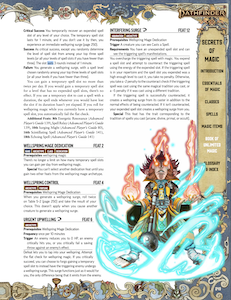 Wellspring Magic
Wellspring Magic
Step aside wild magic of long forgotten times, Wellspring Magic is here. I can’t remember what the PF1e version of this was called, I really don’t think it was wellspring, I thought it was something like primal … but it is 1:33 am here, so I could just be tired. What? Google it? Nah. This is another class archetype taken at 1st level, applied to spontaneous casters, and requiring your 2nd level class feat to be the dedication. There is a variant suggested that would let you apply wellspring to a multiclass, implying that they are struggling to master their new powers; I love this idea. The basic change is that you have one less spell slot per day at each level. When rolling initiative, you roll a flat check and can gain another spell slot based on the roll (16+ is your choice, 6+ is random, failure is a wellspring surge of a random level). As you level up, you can roll this check more often, you can (essentially) gain Fortune on your wellspring surges, cause a surge when you reach 0 HP, and even cause a surge by overpowering another caster’s spell. There is a table with 20 surges, each with an effect that scales based on spell level (a great idea), and includes effects like:
- raw energy causing 2d6 damage per level in a 10 ft burst
- monstrous transformation (bonus to attack/damage; but confused)
- tremors shake the ground, tripping all
- life sap (drained, doomed, and enfeebled)
Wow. That is a lot. Tune in tomorrow as I wrap up my review by looking at the Glossdex! Just kidding.
While I was planning on having an afterthoughts and wrap up piece, I think I want to simply close it out with this perfectly titled and thematic section: Book of Unlimited Magic. That is truly what the Secrets of Magic is all about. The options within are going to improve every game that they touch. I am awed, astounded even, but the work that the wonder staff at Paizo and all of their amazing freelancers were able to cram into the piece of art.
I want to shout out to Ryan and Perram, for indulging me in this oversized review. And Dustin, for being there with the perfect banner every night (or so) as I changed my titles on a whim! Thank you!
And, thanks to you for reading along … As always, please join us at our Discord server https://discord.gg/Rt79BAj to let me know what you think or simply have a chat!

